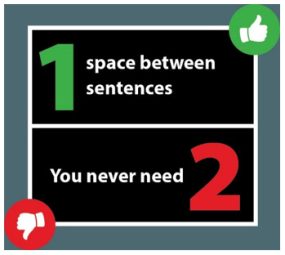One Space Between Sentences

Once upon a time, everyone typed on typewriters, and everyone typed two spaces between sentences.
Typewriters use mono-spaced fonts (like this one), which means that every character gets the same amount of space. So the space for a lowercase “l” is the same size as the space for an uppercase “W,” for example. This makes sentences kind of run together visually. But with two spaces after a period (like after this sentence), it’s more clear that the sentence has ended. People typed like this for many years.
But then word processors and computers came along, and they use variable-width fonts. When everything is proportional, you don’t need two spaces for the visual cue that a sentence has ended. So one space between sentences is now the norm. But some people are still two-spacers—if you learned to type that way, or you just like the look for some reason, it’s not always easy to switch. Passions can get very ignited when the topic comes up.
It isn’t really a debate at this point, though. Every major style guide now recommends one space after a period. The American Psychological Association was one of the last holdouts for two spaces, but it updated its guidelines in 2019. Scientific journals also require one space, even the one that published a study about the benefits of two spaces. And that study itself ends with this: “Thus, while period spacing does influence our processing of text, we should probably be arguing passionately about things that are more important.”
True. But if you enjoy the debate, here are some entertaining articles on the subject: